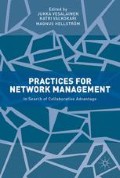Abstract
The future structure and paths of development of dynamic business networks are fundamentally unknowable. The managerial challenge is to influence the development within a business network crossing organizational boundaries. Practical tools are needed to map out how actors’ network strategies actually come into being while organizations continuously interact with each other. The described cases explore sense-making processes between the involved network actors and utilize network pictures as a boundary-spanning tool for strategic management. First, network picturing was utilized by a multinational company to identify the needs of actors in its network and to develop their value propositions under various network scenarios. Second, an SME’s (Small and medium-sized enterprise)most important connections were identified with network picturing to enable the company to drive changes in the network. The broader network perspectives depicted were the end users’ network pictures from different customer segments. In both cases, network picturing resulted in the identification of new relevant network actors and the requirements for building connections to them.
Access this chapter
Tax calculation will be finalised at checkout
Purchases are for personal use only
References
Ford, D., Gadde, L.-E., Håkansson, H., & Snehota, I. (2003). Managing business relationships (2nd ed.). Chichester: John Wiley and Sons.
Hawkins, M. A., & Rezazade, M. M. H. (2012). Knowledge boundary spanning process: Synthesizing four spanning mechanisms. Management Decision, 50(10), 1800–1815.
Henneberg, S., Naudé, P., & Mouzas, S. (2009). Sense-making and management in business networks—Some observations, considerations, and a research agenda. Industrial Marketing Management, 39(3), 355–360.
Jarzabkowski, P., & Seidl, D. (2008). The role of meetings in the social practice of strategy. Organization Studies, 29(11), 1391–1426.
Jarzabkowski, P., Spee, P., & Smets, M. (2013). Material artifacts: Practices for doing strategy with ‘stuff’. European Management Journal, 31(1), 41–54.
Kaartemo, V., Makkonen, H., & Olkkonen, R. (2015). The potential of network pictures for international alliance and network research. In J. Larimo, N. Nummela, & T. Mainela (Eds.), Handbook on international alliance and network research (pp. 229–242). Cheltenham, UK: Edward Elgar.
Kaplan, S. (2011). Strategy and PowerPoint: An inquiry into the epistemic culture and machinery of strategy-making. Organization Science, 22(2), 320–346.
Koskinen, K. U., & Mäkinen, S. (2009). Role of boundary objects in negotiations of project contracts. International Journal of Project Management, 27, 31–38.
Laari-Salmela, S., Mainela, T., & Puhakka, V. (2015). Beyond network pictures: Situational strategizing in network context. Industrial Marketing Management, 45, 117–127.
Mattsson, L. G. (2002). Dynamics of markets: How ‘Actor-Network Theory’ and ‘Markets-as-Networks’ can learn from each other. Paper presented at the Nordic Workshop on Interorganizational Studies, Kolding, August 2002.
Miesing, P., & Van Ness, R. K. (2007). Exercise: Scenario planning. Organization Management Journal, 4(2), 148–167.
Moliterno, T. P., & Mahony, D. M. (2010). Network theory of organization: A multilevel approach. Journal of Management, 37(2), 443–467.
Parmigiani, A., & Rivera-Santos, M. (2011). Clearing a path through the forest: A meta-review of interorganizational relationships. Journal of Management, 37(4), 1108–1136.
Ramos, C., & Ford, I. D. (2010). Network pictures as a research device: Developing a tool to capture actors’ perceptions in organizational networks. Industrial Marketing Management, 40(3), 447–464.
Valkokari, K. (2015). Describing network dynamics in three different business nets. Scandinavian Journal of Management, 31(2), 219–231. Weick, K. E. (1995) Sensemaking in organizations. Thousand Oaks, CA: Sage.
Weick, K. E. (1995). Sensemaking in organizations. Thousand Oaks, CA: Sage.
Author information
Authors and Affiliations
Editor information
Editors and Affiliations
Rights and permissions
Copyright information
© 2017 The Author(s)
About this chapter
Cite this chapter
Valjakka, T., Kaartemo, V., Valkokari, K. (2017). Making Sense of Network Dynamics through Network Picturing. In: Vesalainen, J., Valkokari, K., Hellström, M. (eds) Practices for Network Management . Palgrave Macmillan, Cham. https://doi.org/10.1007/978-3-319-49649-8_5
Download citation
DOI: https://doi.org/10.1007/978-3-319-49649-8_5
Published:
Publisher Name: Palgrave Macmillan, Cham
Print ISBN: 978-3-319-49648-1
Online ISBN: 978-3-319-49649-8
eBook Packages: Business and ManagementBusiness and Management (R0)

